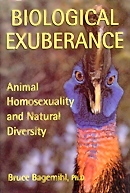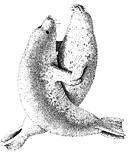
Gay/Lesbian/Feminist Bookstores Around the Country
The Mostly Unfabulous Homepage of Ethan Green
![]()


Formidable Fathers and Supernormal Mothers: Homosexual Parenting
From Biological Exuberance
Same-sex pairs in many
species (especially birds) raise young together. Not only are
they competent parents, homosexual pairs sometimes actually exceed
heterosexual ones in the number of eggs they lay, the size of
their nests, or the skill and extent of their parenting.
How are such animals able to have offspring in the first place if they are in homosexual associations? Many different strategies are used, including several in which one or both partners are the biological parent(s) of the young they raise together. The most common parenting arrangement of this type is found in lesbian pairs of several Full, Tern, and Goose species: one or both female partners copulate with a male to fertilize her eggs. No bonding or long-term association develops between the female and the male (who is essentially a "sperm donor" to the homosexual pair), and the youngsters are then jointly raised by both females without any assistance from a male parent.
 |
| Two male Harbor Seals "pair-rolling" (a courtship and sexual behavior) Illustration by John Megahan, © 1999. |
Sometimes two female animals who already have offspring join forces, bonding together and raising their young as a same-sex family unit (among mammals, female coparents may even suckle each other's young): this occurs in Grizzly Bears, Red Foxes, Warthogs, Dwarf Cavies, Lesser Scaup Ducks, and Sage Grouse. Notably, heterosexual pairs do not occur in these species, and most offspring are otherwise raised by single females.
In some species, a nonbreeding animal bonds with a (single) breeding animal and helps parent its young: this occurs in Squirrel Monkeys, Northern Elephant Seals, Jackdaws (where a widowed female with young may pair with a single female), and Greater Rheas (where one male may help another incubate his eggs and then raise the young together.)
In most such joint parenting arrangements (as opposed to homosexual mated pairs), there is not necessarily any overt courtship or sexual activity between the bonded coparents, although is some species (e.g. Squirrel Monkeys, Northern Elephant Seals, Emus, Sage Grouse), homosexual activity does occur in contexts other than between coparents. Still other birds (e.g., Greylag Geese, Common Gulls, Oystercatchers) may form bisexual parenting trios, mating with the opposite-sexed partner(s) in their association while maintaining homosexual and heterosexual bonds simultaneously, with all three birds then raising the resulting offspring together. A variation on this arrangement in Black Swans involves a sort of "surrogate motherhood": established male homosexual pairs sometimes associate temporarily with a female, mating with her to father their own offspring. Once the eggs are laid, however, they chase her away and raise the cygnets on her own as a homosexual couple.
In a number of cases, homosexual pairs raise young without being the biological parents of the offspring they care for. Some same-sex pairs adopt young: two female Northern Elephant Seals occasionally adopt and coparent an orphaned pup, while male Hooded Warblers and Black-headed Gulls may adopt eggs or entire nests that have been abandoned by females, and pairs of male Cheetahs occasionally look after lost cubs.
Sometimes female birds "donate" eggs to homosexual couples through a process known as parasitism: in many birds, females lay eggs in nests other than their own, leaving the parenting duties to the "host" couple. This occurs both within the same species, and (more commonly) across species, and usually involves heterosexual hosts. Male pairs of Hooded Warblers, however, sometimes receive eggs from Brown-headed Cowbirds (and possibly also from females of their own species) in this way; within-species parasitism may also provide eggs for male pairs of Black-headed Gulls and female pairs in Roseate and Caspian Terns.
The opposite situation is thought to occur in Ring-billed Gulls: researchers believe that some homosexually paired females actually lay eggs in nests belonging to heterosexual pairs. Finally, some birds in same-sex pairs take over or "kidnap" nests from heterosexual pairs (e.g., in Caspian and Roseate Terns, Black-headed Gulls); homosexual pairs in captivity also raise foster young provided to them.
In a detailed study of parental behavior by female pairs of Ring-billed Gulls, scientists found no significant differences in quality of care provided by homosexual as opposed to heterosexual parents. They concluded that there was not anything that male Ring-billed Gull parents provided that two females could not offer equally well.
This case is not exceptional: homosexual parents are generally as good at parenting as heterosexual ones. Examples of same-sex pairs successfully raising young have been documented in at least 20 species, and in a few cases, homosexual couples actually appear to have an advantage over heterosexual ones. Pairs of male Black Swans, for example, are often able to acquire the largest and best-quality territories for raising young because of their combined strength. Such fathers -- dubbed "formidable" adversaries by one scientist -- consequently tend to be more successful at raising offspring than most heterosexual pairs. And in many species in which single parenting is the rule (because there is no heterosexual pair-bonding), same-sex pairs provide a unique opportunity for young to be raised by two parents (e.g., Squirrel Monkeys, Grizzly Bears, Lesser Scaup Ducks.) Moreover, in some Gulls, female pairs are consigned (for a variety of reasons) to less than optimal territories, yet they still successfully raise young: in many cases they compensate by investing more parental effort -- and are more dutiful in caring for their chicks -- than male-female pairs.
There are exceptions, of course: some female pairs of Gulls, for instance, tend to lay smaller eggs and raise fewer chicks (although this is also true of heterosexual trios attending supernormal clutches), while same-sex parents in Jackdaws, Canada Geese, and Oystercatchers may experience parenting difficulties such as egg breakage or nonsynchronization of incubation duties. By and large, though, same-sex couples are competent and occasionally even superior parents.
Sounds good, right? Read more:
- Intro, Biological Exuberance: Now that's a wild kingdom.
- Ritual: Guess which humal ritual began as monkey diddling.
- The Perversion of Scientific Discourse: Why would some experts call animals "immoral" or "sinful."
- Biodiversity = Sexual Diversity: Why sexual diversity is essential to survival.
- Why Biological Exuberance?: Author Bruce Bagemihl explains the thoughts behind the book.
Copyright © 1999 Bruce Bagemihl.

 Back
to the Stonewall Inn
Back
to the Stonewall Inn